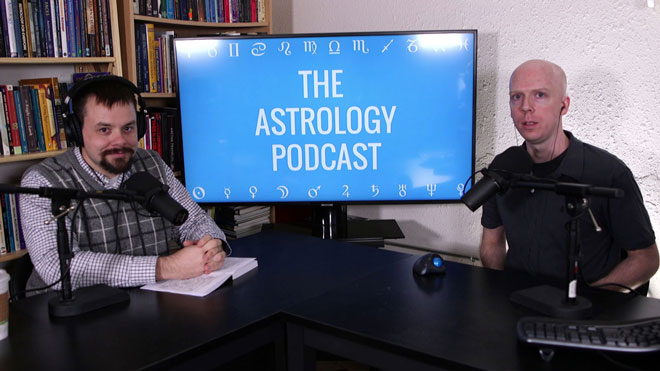
In episode 181 of the podcast Dr. Jeffrey Kotyk joins the show to talk about the practice of astrology in China in ancient times, and in particular the transmission of horoscopic astrology to China and Japan starting in the 9th century.
Jeffrey is an academic historian from Winnipeg, Canada, who specializes in the study of astrology in pre-modern Asia. He completed a PhD dissertation at Leiden University in 2017 titled Buddhist Astrology and Astral Magic in the Tang Dynasty.
A major part of his research has focused on investigating the transmission of horoscopic astrology to China and Japan starting in the 9th century. Horoscopic astrology or horoscopy here is defined as the type of astrology that uses the Ascendant and twelve houses, which was developed in the west around the 1st century BCE.
According to Jeffrey, the principal source of this transmission was the text of the Greco-Roman astrologer Dorotheus of Sidon, which was originally written in Greek in the late 1st century CE. Dorotheus was translated into Persian around the 3rd century, and then it was translated from Persian into Chinese around the year 800 CE.
During the course of our interview we discuss the origins of Chinese astrology, and how the indigenous form of mundane astrology developed there around the 2nd century BCE, and later came to be practiced alongside western natal astrology derived from Dorotheus.
Jeffrey recently wrote a concise overview of much of his research on this topic in a post on his blog titled Horoscopy in East Asia: Some Thoughts. You can read his dissertation and other academic papers he has written through his page on Archive.org.
Show Notes
Here is an outline of some of the main points we touched on in the episode:
- Jeffrey’s focus is academic studies on astrology in pre-modern Asia.
- The life and work of David Pingree (1933-2005).
- The work of Yano Michio.
- Why has astrology been neglected in the study of China and Japan?
- Historical background: Native Chinese celestial omenology.
- Nakṣatra (lunar mansion) astrology in India.
- Early Buddhist interest in astrology: lunation used for scheduling monastic meetings (pakṣas and tithis).
- Translation of Buddhist scriptures into China containing astrology.
- Navagraha-karaṇa translated in 718 by Gautama Siddhārtha: Indian astronomy in China.
- The use of astrology in timing rituals in Esoteric Buddhism: seven-day week, etc.
- Śubhakarasiṃha (637–735) and his colleague Yixing (673–727).
- Amoghavajra’s (705–774) astrology manual: Xiuyao jing (Scripture of Constellations and Planets), produced in 759 with a subsequent revision in 764.
- The difficulty of implementing nakṣatras into Chinese observational astronomy.
- The navāṃsas or ninths of a zodiac sign.
- The method of tārā-cakra (“Star Wheel”), or nava-tārā (“Nine Stars”).
- Li Miqian and the introduction of Dorotheus into China in the 9th century.
- Dorothean material in Chinese sources (triplicity rulers, lots, decans).
- Was the translated material purely Dorotheus? Lunar mansions.
- The use of lots in Chinese horoscopy.
- The popularity of annual profections. Natal horoscope of 3 October 930 CE produced on 25 January 975 by Kang Zun.
- The use of the whole sign house system in East Asian horoscopy.
- Introduction of Ptolemaic astrology into China via the al-Madkhal by Kūšyār ibn Labbān in the late 14th century.
- Horoscopy in 16th century China: Wan Minying.
- Sukuyōdō: Japanese Buddhist astrology from the 10th to 14th centuries.
- Astral magic: what was it?
- Astral deities in ancient Chinese lore and Daoist worship of the Big Dipper.
- The planets as deities: a Mesopotamian concept that spread to China via Buddhism.
- Parallels between astral magic in medieval Daoist + Buddhist sources and the Picatrix.
- Japanese Star Mandalas.
Podcast: Play in new window | Download (Duration: 1:35:44 — 66.1MB)


Very interesting, thank you.
For electional and predictive “astrology” Bazi (eight characters or four pillars) was and still is used. The assignment of planets (elements) to houses (branches), however, is the same as in Hellenistic astrology (with one change). Oppositions, squares, trines and triplicities are used. Only sextiles have been transformed to something else. A coincidence?
An interesting development based on Western horoscopic astrology is the birth of other methods (for example zǐwéi dǒushǔ and guǒlǎo xīngzōng), which use essentially the same houses, but in different orders.
In an ancient astrological divination method called Taiyi the board is set up quite in the same manner as lots are used in Arabic astrology.
This opens up new worlds, thank you both very much.
Hi, What was the name of the Iranian version of Lilith ? “Awl” how is this spelled.
Michal:
Here is a source on this deity:
http://www.iranicaonline.org/articles/al-folkloric-being-that-personifies-puerperal-fever
Excellent guest speaking on a topic I have long wondered about. Very informative. I’m quite familiar with the Sino-Platonic papers & I’m also on Academia.edu so I very much look forward to reading more from Mr. Kotyk. I would definitely like to see another episode going a little deeper into the concepts in Chinese astrology that are different from Hellenistic astrology.
Chris: I think the on camera interview worked quite well, A/V and all, but you also had a very good speaker 😉
Fabulous episode. Thank you gentlemen. I have been reading large sections of Dr Kotyk’s dissertation with great interest. I’m particularly fascinated by Japanese astral magic and venerations of the big dipper and circumpolar stars. Is there an English translation of one of these original texts? Such as the “Ritual of the Northern Dipper”? Would LOVE to see a book of Japanese Astral Magic! Astral veneration is in a rediscovery phase—just as Traditional Astrology is making a comeback. Fascinating times!
[…] episode acts as a nice companion piece to episode 181, where I interviewed Dr. Jeffrey Kotyk about the history of astrology in China prior to modern […]
Excellent!
Question? Is the Chinese Shouxing, the old man with a staff and usually a peach of immortality and a crane, who signifies longevity related to Iranian or Western traditions?
There are several misinformations in this episode, I’ll name but two, one is the idea that the Himalayas had anything to do with cultural transmission rates between what is today China and the rest of the world, specifically India and ancient Mesopotamia, this is pure nonsense that even a cursory read of a wikipedia article on the subject should put to rest but there are better sources as well equally easy to access. Central Asia was the getaway to the south and west long before the actual ‘silk road’ developed, and it continued to be so long after the south-eastern sea roads were developed. Second, the Chinese ‘lunar mansions’ and constellations are not based on the ecliptic, at all. But there are other fallacies and inaccuracies mentioned as well. Also, the guest is very very right not to call whatever celestial observation history the ancients developed in what is today China astrology. Even calling it a systematic omen art in the fashion of the Enuma Anu Enlil would be misleading. It’s equally misleading to ascribe an unsubstantiated age to what are called the Indian lunar mansions, and it’s far worse to assume that they were ‘used’ in any way similar to the omen art developed in Mesopotamia or even worse the astrological practice and art developed in Hellenistic Egypt. But this last thought is not that relevant to this episode. For me the most interesting part has to be the discussion on the transmission of Dorotheus to China and Japan probably via the Sassanids while they were fleeing the Arab invasion. This is especially interesting if we are to ‘reconstruct’ Dorotheus.